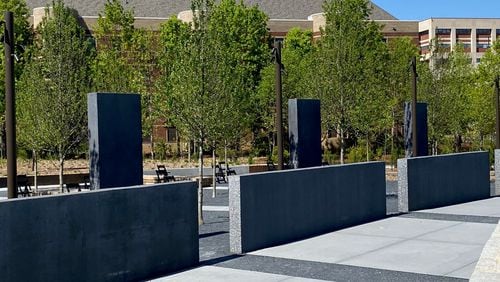Georgia Tech officials and student leaders unveiled a memorial on its campus Wednesday at the former site of the Pickrick Restaurant to commemorate the effort nearly 60 years ago to desegregate the establishment that became infamous when its owner, Lester Maddox, drew a handgun on Black patrons.
Three rectangular pillars now stand on the site, representing the three Interdenominational Theological Center students who attempted to desegregate the restaurant. It is part of the school’s EcoCommons, an 8-acre site with more than 600 new trees, 68 transplanted trees, tens of thousands of new perennials and shrubs and other plants.
After the federal Civil Rights Act passed in 1964, the three ITC students — George Willis Jr., Albert Dunn, and Woodrow T. Lewis — attempted to desegregate the Pickrick. Photos of Maddox chasing the Black students away with his gun made national headlines. The students hired Black attorney Constance Baker Motley, who successfully won a federal lawsuit arguing Maddox violated the new act. Rather than comply with the court order to desegregate, Maddox closed the restaurant. Maddox became governor in 1967 and held office for a four-year term. He died in 2003.
Georgia Tech bought the property in 1965 and leveled the building in 2008.
For years, some on campus referred to the site as the Pickrick. No more, said Georgia Tech President Ángel Cabrera. He suggested it now be known as the “Unity Garden.”
“It is a reminder that out of healing comes resilience, strength,” Cabrera said. “By recognizing our past, we’re bound to get stronger and build a better future for everybody. That’s what this space means to me. That’s what it represents.”







